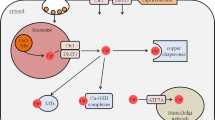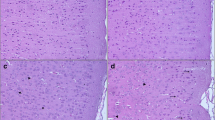Abstract
Copper is a trace element required to maintain essential life processes. In healthy organisms, copper metabolism is well balanced. If this balance is destroyed, the cellular level of free copper might increase and cause toxic effects. So far, the molecular mechanisms of copper intoxication are understood only partly. The present study revealed that the kinesin-dependent transport system is strongly affected by copper(II) ions. Both the microtubules, along which kinesin moves, and the kinesin itself were found to be the target structures of copper ions: Microtubule formation was suppressed by copper ions (IC50 26–70 µM) apparently chiefly by inhibition of binding of microtubule-associated proteins to tubulin. This inhibition could be widely compensated by the microtubule-stabilising agent paclitaxel. In addition, copper ions strongly inhibited the ATPase activity of neuron-specific kinesin KIF5A. At final KIF5A concentration of 112 nM, an IC50 of 1.3 µM was determined. Correspondingly, the motility activity of KIF5A, measured as velocity of microtubules gliding across a kinesin-covered surface, was blocked. The effects of copper ions on microtubules and on KIF5A are suggested to contribute to impaired transport processes within brain and other organs in cases of copper ion surplus.




Similar content being viewed by others
References
Amsler PE, Sigel H (1976) Comparison of the metal-ion-promoted dephosphorylation of the 5′-triphosphates of adenosine, inosine, guanosine and cytidine by Mn2+, Ni2+ and Zn2+ in binary and ternary complexes. Eur J Biochem 63(2):569–581
Böhm KJ (2014) Kinesin-dependent motility generation as target mechanism of cadmium intoxication. Toxicol Lett 224:356–361. doi:10.1016/j.toxlet.2013.11.004
Böhm KJ, Stracke R, Baum M, Zieren M, Unger E (2000) Effect of temperature on kinesin-driven microtubule gliding and kinesin ATPase activity. FEBS Lett 466(1):59–62
Bonacker D, Stoiber T, Wang MS, Böhm KJ, Prots I, Unger E, Thier R, Bolt HM, Degen GH (2004) Genotoxicity of inorganic mercury salts based on disturbed microtubule function. Arch Toxicol 78(10):575–583. doi:10.1007/s00204-004-0578-8
Bonacker D, Stoiber T, Böhm KJ, Prots I, Wang MS, Unger E, Thier R, Bolt HM, Degen GH (2005) Genotoxicity of inorganic lead salts and disturbance of microtubule function. Environ Mol Mutagen 45(4):346–353. doi:10.1002/Em.20100
Bush AI (2000) Metals and neuroscience. Curr Opin Chem Biol 4(2):184–191
Cohn SA, Ingold AL, Scholey JM (1989) Quantitative analysis of sea urchin egg kinesin-driven microtubule motility. J Biol Chem 264(8):4290–4297
de Bie P, Muller P, Wijmenga C, Klomp LW (2007) Molecular pathogenesis of Wilson and Menkes disease: correlation of mutations with molecular defects and disease phenotypes. J Med Genet 44(11):673–688
Deinum J, Wallin M, Lagercrantz C (1981) Spatial separation of the two essential thiol groups and the binding site of the exchangeable GTP in brain tubulin. A spin label study. Biochim Biophys Acta 671(1):1–8
Desai V, Kaler SG (2008) Role of copper in human neurological disorders. Am J Clin Nutr 88(3):855S–858S
Furukawa T, Komatsu M, Ikeda R, Tsujikawa K, Akiyama S (2008) Copper transport systems are involved in multidrug resistance and drug transport. Curr Med Chem 15(30):3268–3278
Gaskin F, Cantor CR, Shelanski ML (1974) Turbidimetric studies of the in vitro assembly and disassembly of porcine neurotubules. J Mol Biol 89(4):737–755
Hackney DD (1994) The rate-limiting step in microtubule-stimulated ATP hydrolysis by dimeric kinesin head domains occurs while bound to the microtubule. J Biol Chem 269(23):16508–16511
Hartter DE, Barnea A (1988) Brain tissue accumulates 67copper by two ligand-dependent saturable processes. A high affinity, low capacity and a low affinity, high capacity process. J Biol Chem 263(2):799–805
Hirokawa N, Niwa S, Tanaka Y (2010) Molecular motors in neurons: transport mechanisms and roles in brain function, development, and disease. Neuron 68(4):610–638. doi:10.1016/j.neuron.2010.09.039
Holloway JH, Reilley CN (1960) Metal chelate stability constants of aminopolycarboxylate ligands. Anal Chem 32(2):249–256. doi:10.1021/Ac60158a033
Jellinger KA (2013) The relevance of metals in the pathophysiology of neurodegeneration, pathological considerations. Int Rev Neurobiol 110:1–47. doi:10.1016/B978-0-12-410502-7.00002-8
Kalchishkova N, Böhm KJ (2008) The role of kinesin neck linker and neck in velocity regulation. J Mol Biol 382(1):127–135. doi:10.1016/j.jmb.2008.06.092
Kardos J, Kovacs I, Hajos F, Kalman M, Simonyi M (1989) Nerve endings from rat brain tissue release copper upon depolarization. A possible role in regulating neuronal excitability. Neurosci Lett 103(2):139–144
Karle KN, Mockel D, Reid E, Schols L (2012) Axonal transport deficit in a KIF5A(−/−) mouse model. Neurogenetics 13(2):169–179. doi:10.1007/s10048-012-0324-y
Kendrick MJ, May MT, Plishka MJ, Robinson KD (1992) Magnesium in biological systems. In: Kendrick MJ et al (eds) Metals in biological systems, Ellis Horwood series in inorganic chemistry, Ellis Horwood Ltd., New York, pp 57–65
Laemmli UK (1970) Cleavage of structural proteins during the assembly of the head of bacteriophage T4. Nature 227(5259):680–685
Martic S, Rains MK, Kraatz HB (2013) Probing copper/tau protein interactions electrochemically. Anal Biochem 442(2):130–137. doi:10.1016/j.ab.2013.07.015
Monteiro SM, Mancera JM, Fontainhas-Fernandes A, Sousa M (2005) Copper induced alterations of biochemical parameters in the gill and plasma of Oreochromis niloticus. CBP 141(4):375–383. doi:10.1016/j.cbpc.2005.08.002
Morel M, Heraud C, Nicaise C, Suain V, Brion JP (2012) Levels of kinesin light chain and dynein intermediate chain are reduced in the frontal cortex in Alzheimer’s disease: implications for axoplasmic transport. Acta Neuropathol 123(1):71–84. doi:10.1007/s00401-011-0901-4
Niclas J, Navone F, Hom-Booher N, Vale RD (1994) Cloning and localization of a conventional kinesin motor expressed exclusively in neurons. Neuron 12(5):1059–1072
Niwa S, Takahashi H, Hirokawa N (2013) beta-Tubulin mutations that cause severe neuropathies disrupt axonal transport. EMBO J 32(10):1352–1364. doi:10.1038/emboj.2013.59
Pushkar Y, Robison G, Sullivan B, Fu SX, Kohne M, Jiang W, Rohr S, Lai B, Marcus MA, Zakharova T, Zheng W (2013) Aging results in copper accumulations in glial fibrillary acidic protein-positive cells in the subventricular zone. Aging Cell 12(5):823–832. doi:10.1111/acel.12112
Roos PM, Vesterberg O, Syversen T, Flaten TP, Nordberg M (2013) Metal concentrations in cerebrospinal fluid and blood plasma from patients with amyotrophic lateral sclerosis. Biol Trace Elem Res 151(2):159–170. doi:10.1007/s12011-012-9547-x
Sakakibara A, Ando R, Sapir T, Tanaka T (2013) Microtubule dynamics in neuronal morphogenesis. Open biol 3(7):130061. doi:10.1098/rsob.130061
Sarell CJ, Wilkinson SR, Viles JH (2010) Substoichiometric levels of Cu2+ ions accelerate the kinetics of fiber formation and promote cell toxicity of amyloid-{beta} from Alzheimer disease. J Biol Chem 285(53):41533–41540. doi:10.1074/jbc.M110.171355
Schaap IA, Carrasco C, de Pablo PJ, Schmidt CF (2011) Kinesin walks the line: single motors observed by atomic force microscopy. Biophys J 100(10):2450–2456. doi:10.1016/j.bpj.2011.04.015
Schiff PB, Horwitz SB (1981) Taxol assembles tubulin in the absence of exogenous guanosine 5′-triphosphate or microtubule-associated proteins. Biochemistry-Us 20(11):3247–3252
Schiff PB, Fant J, Horwitz SB (1979) Promotion of microtubule assembly in vitro by taxol. Nature 277(5698):665–667
Shelanski ML, Gaskin F, Cantor CR (1973) Microtubule assembly in the absence of added nucleotides. Proc Natl Acad Sci 70(3):765–768
Singh I, Sagare AP, Coma M, Perlmutter D, Gelein R, Bell RD, Deane RJ, Zhong E, Parisi M, Ciszewski J, Kasper RT, Deane R (2013) Low levels of copper disrupt brain amyloid-beta homeostasis by altering its production and clearance. Proc Natl Acad Sci USA 110(36):14771–14776. doi:10.1073/pnas.1302212110
Sloboda RD, Dentler WL, Rosenbaum JL (1976) Microtubule-associated proteins and the stimulation of tubulin assembly in vitro. Biochemistry-Us 15(20):4497–4505
Telianidis J, Hung YH, Materia S, Fontaine SL (2013) Role of the P-type ATPases, ATP7A and ATP7B in brain copper homeostasis. Front Aging Neurosci 5:44. doi:10.3389/fnagi.2013.00044
Thier R, Bonacker D, Stoiber T, Böhm KJ, Wang M, Unger E, Bolt HM, Degen G (2003) Interaction of metal salts with cytoskeletal motor protein systems. Toxicol Lett 140–141:75–81
Tucker C, Goldstein LSB (1997) Probing the kinesin–microtubule interaction. J Biol Chem 272(14):9481–9488
Wallin M, Larsson H, Edstrom A (1977) Tubulin sulfhydryl groups and polymerization in vitro. Effects of di- and trivalent cations. Exp Cell Res 107(1):219–225
Weingarten MD, Lockwood AH, Hwo SY, Kirschner MW (1975) A protein factor essential for microtubule assembly. Proc Natl Acad Sci 72(5):1858–1862
Wimalasena DS, Wiese TJ, Wimalasena K (2007) Copper ions disrupt dopamine metabolism via inhibition of V–H+-ATPase: a possible contributing factor to neurotoxicity. J Neurochem 101(2):313–326. doi:10.1111/j.1471-4159.2006.04362.x
Woehlke G, Ruby AK, Hart CL, Ly B, HomBooher N, Vale RD (1997) Microtubule interaction site of the kinesin motor. Cell 90(2):207–216
Acknowledgments
The author is very grateful to Mrs Marina Wollmann for her skilful excellent assistance in technical performing the experiments described in this study.
Author information
Authors and Affiliations
Corresponding author
Rights and permissions
About this article
Cite this article
Böhm, K.J. Elevated copper ion levels as potential cause of impaired kinesin-dependent transport processes. Arch Toxicol 89, 565–572 (2015). https://doi.org/10.1007/s00204-014-1272-0
Received:
Accepted:
Published:
Issue Date:
DOI: https://doi.org/10.1007/s00204-014-1272-0




